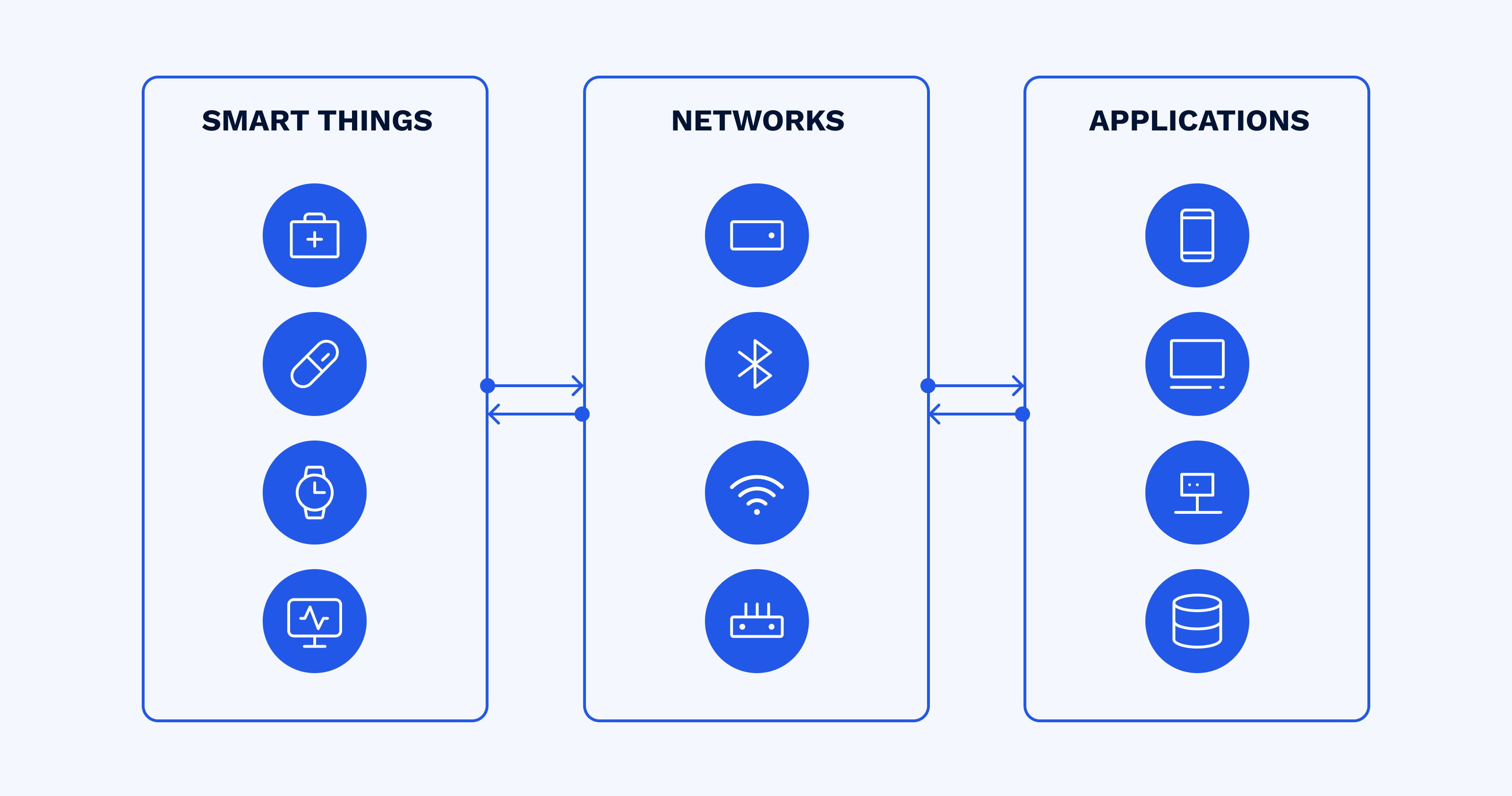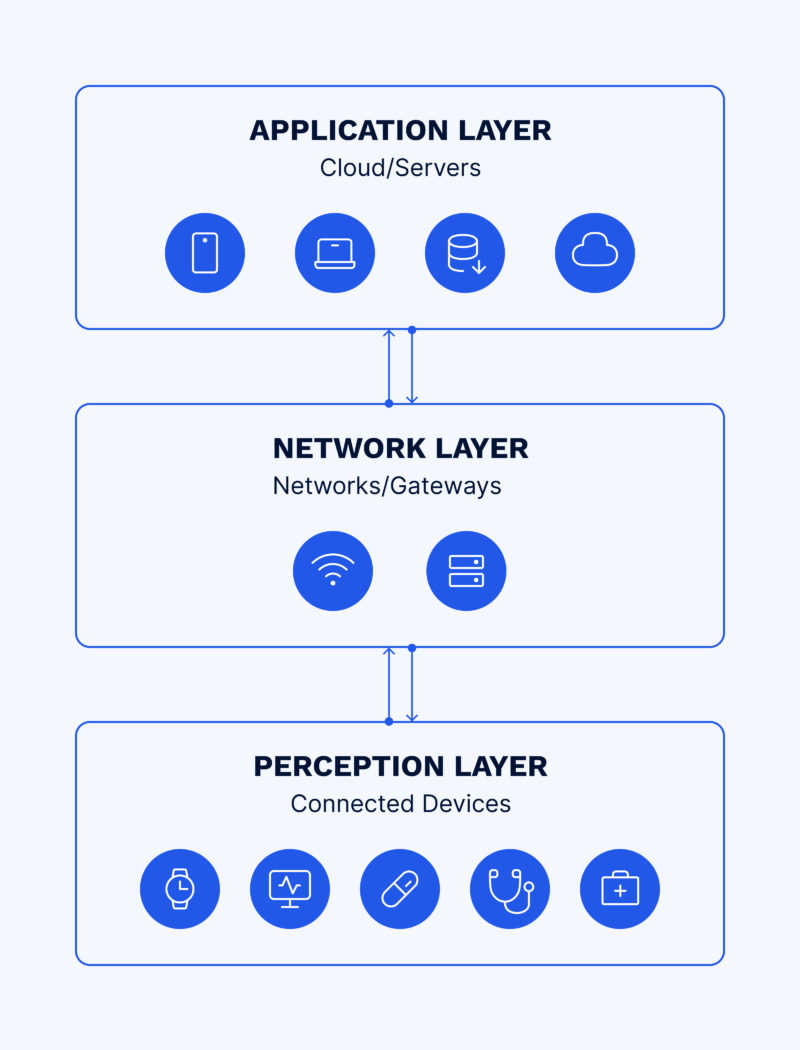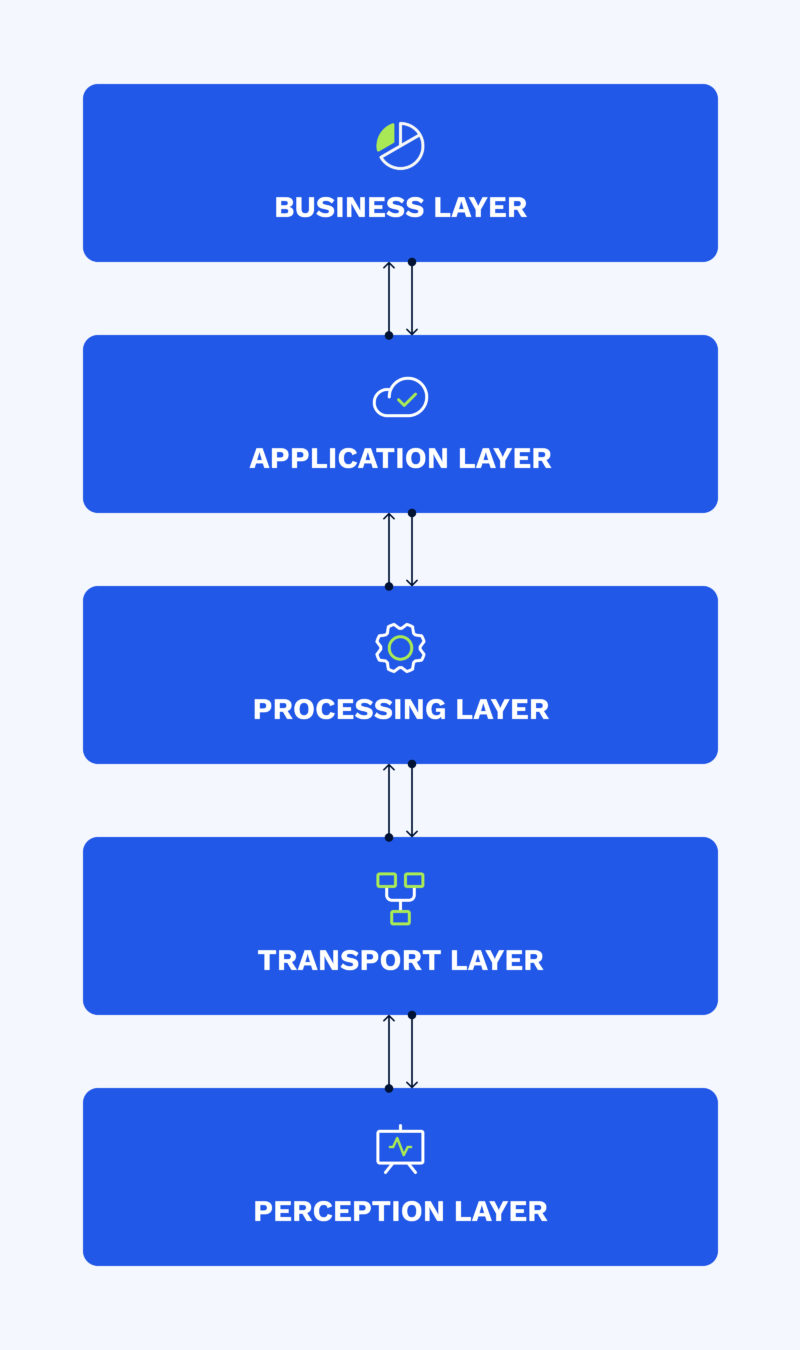
Contact us
Our team would love to hear from you.

Above all, building a Smart Hospital means rethinking the entire hospital concept. The concept of a Smart Hospital can be described as a composable IT ecosystem where all critical insights are a click away. In order to create an ecosystem with hardware and software solutions that work in harmony with clinical workflows, it is necessary to design a resilient, energy-efficient, code-compliant infrastructure.
Given the rapid rise of the Internet of things (IoT) and its numerous capabilities, it is now possible to create such an infrastructure. Relevant IoT capabilities, which provide a solid foundation for building a high-tech hospital or smart hospital rooms, include broad-gauge data collection, reliable data transmission, and smart processing.
IoT-based Smart Hospital infrastructure includes building blocks that are common to all use cases:

IoT building blocks for high-tech hospitals
These building blocks support a multi-layered, IoT-based system.
To better understand them, we will explain what, why, and where the above-mentioned components are built into the IoT infrastructure based on the example of a three-layer architecture.

Smart hospital example layers
The three-layer architecture comprises the perception, network, and application layers.
The perception layer is where the first set of building blocks — connected devices — plays a major role. These devices generate data that is collected and transmitted to the next layer. Networks and gateways serve as intermediaries between physical devices and servers or cloud, and constitute the network level. Gateways can be implemented in the form of physical devices or software. In addition to the normalization and transfer of data, modern gateways pre-process and filter raw data, encrypt data before it is transferred over the networks, and facilitate security monitoring. In general, networks enable communication between connected devices and the application layer.
Clouds or remote servers in the application layer are the core of the entire infrastructure. Due to their powerful services, data storage and big data processing are enabled, and 3rd party APIs and UIs are implemented.

Key layers of architecture and technology for Smart hospital system
With these basic concepts in mind, we can proceed with the five-layer architecture, which comprises perception, transport, processing, application, and business layers.
The perception layer, as we mentioned before, is all about physical devices and the data they generate. The devices are connected to the networks to enable the exchange of generated and collected data.
The transport layer enables data transfer from the perception layer to the processing layer. It also provides network-level security measures.
The processing layer stores, analyzes, and processes data sets received from the perception layer. Data from all sources are accumulated here to be placed into the respective data storage depending on data type (structured or unstructured). Next, the data is transformed and undergoes preliminary analysis so that the required portion of it can be used in the application and business layers.
The application layer addresses user requirements by delivering application-specific data and services to stakeholders. The applications vary depending on the stakeholders and the information they must provide. Examples include IoT device monitoring software and process monitoring software.
The business layer is a core element of the five-layer architecture. Its broad responsibilities can vary from advanced analytics to controlling application layer functionality (i.e., it provides advanced analytics, defines the rules of how the application layer interacts with users, etc). It facilitates the management of end-to-end business decisions, the creation of healthcare facility revenue, cost reduction, and healthcare service improvements.
The volume of the smart hospital market is growing from year to year. Today, more and more smart devices for healthcare are coming into the market. Therefore, it is necessary to ensure that with their integration, a Smart Hospital’s concept is flawless and the Smart Hospital’s infrastructure works like a well-oiled machine. In this regard, the implementation of edge computing technology and proper security measures plays a critical role.
Given the expanding role of IoT in healthcare, healthcare facilities are seeking more robust computing technologies for IoT systems and trusted providers for IoT software development. Edge computing, in combination with IoT, helps in cases when speed matters. Even though cloud architecture helps solve numerous data storage and processing issues, latency and availability hiccups still arise in cloud solutions. Thus, edge-computing components are often integrated into the IoT systems of a healthcare facility. Using edge computing, healthcare service providers bring data sources as close as possible to the connected devices. The main advantages of data processing at the “edge” of the data collection point are as follows:
To explore the benefits listed above, employing 5G technology is worth considering. Combined with edge computing, 5G offers ultra-low latency and high speed, which are critical for medical care.
Security is the most critical issue in IoT-based intelligent hospital systems due to vulnerable IoT devices and continuous data transfer within the Smart Hospital ecosystem. Considering the rising number of security threats, security measures that cover all the layers described above are a necessity.
There are three pillars of IoT architecture that must be protected: devices, connectivity, and the cloud.
Smart devices in hospitals are protected in two ways. On the one hand, from the manufacturer’s side, they are protected with embedded devices for authentication and endpoint protection as well as secure boot to prevent unauthorized code from running. On the other hand, user-side protection includes regular updates of security patches and physical protection, like metal cases or shields.
Connection security is mainly achieved through the encryption of data being sent over devices, networks, or applications. To ensure end-to-end data protection, standard Transport Layer Security cryptographic protocol can be used for IoT messaging protocols like MQTT, AMQP, and DDS.
Cloud security is important in relation to data stored in the cloud; it aims to mitigate risks from unwanted persons’ access to sensitive information. Security measures include the following:
In terms of IoT system protection, it is also worth mentioning the security of its data at rest. Data at rest is often considered as less vulnerable than data traveling within a network (in motion) and thus is not always properly protected. As a result, attackers often see it as their target. Therefore, it is critical to provide security at rest that involves the encryption of data before placing it in storage or the encryption of storage itself is extremely important. In addition, such measures are required to ensure both HIPAA and GDPR compliance.
There can’t be too much security. Therefore, it is always worth ensuring that security is tight at all levels, from the smallest devices to all-encompassing systems.
In addition, Medigate and CrowdStrike, the leaders in healthcare security, provide several recommendations that can help resist attacks:
At EffectiveSoft, we always emphasize the importance of security. Therefore, we include a highly skilled security specialist in our development teams.
There are several things to have in mind when planning the development of a Smart Hospital:
In the modern world, Smart Hospital projects must be placed high on the agenda of every healthcare executive even though they are a costly investment. By integrating with a hospital’s existing technologies and designing new Smart Hospital software, EffectiveSoft helps healthcare facilities focus more on delivering care and spend less time on things that can be automated and performed by smart systems. Thoughtful and well-implemented Smart Hospital design can give you access to these incredible possibilities.
If you are in search of high-quality healthcare software development services, turn to EffectiveSoft. We have significant experience in the domain and an extensive portfolio. Contact us to learn more.
Our team would love to hear from you.
Fill out the form, and we’ve got you covered.
What happens next?
San Diego, California
4445 Eastgate Mall, Suite 200
92121, 1-800-288-9659
San Francisco, California
50 California St #1500
94111, 1-800-288-9659
Pittsburgh, Pennsylvania
One Oxford Centre, 500 Grant St Suite 2900
15219, 1-800-288-9659
Durham, North Carolina
RTP Meridian, 2530 Meridian Pkwy Suite 300
27713, 1-800-288-9659
San Jose, Costa Rica
C. 118B, Trejos Montealegre
10203, 1-800-288-9659